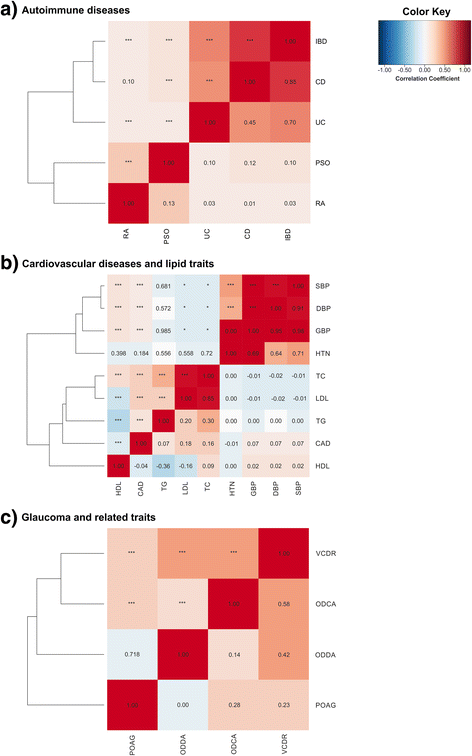Genetic pleiotropy between age-related macular degeneration and 16 complex diseases and traits
- PMID: 28347358
- PMCID: PMC5368911
- DOI: 10.1186/s13073-017-0418-0
Genetic pleiotropy between age-related macular degeneration and 16 complex diseases and traits
Abstract
Background: Age-related macular degeneration (AMD) is a common condition of vision loss with disease development strongly influenced by environmental and genetic factors. Recently, 34 loci were associated with AMD at genome-wide significance. So far, little is known about a genetic overlap between AMD and other complex diseases or disease-relevant traits.
Methods: For each of 60 complex diseases/traits with publicly available genome-wide significant association data, the lead genetic variant per independent locus was extracted and a genetic score was calculated for each disease/trait as the weighted sum of risk alleles. The association with AMD was estimated based on 16,144 AMD cases and 17,832 controls using logistic regression.
Results: Of the respective disease/trait variance, the 60 genetic scores explained on average 4.8% (0.27-20.69%) and 16 of them were found to be significantly associated with AMD (Q-values < 0.01, p values from < 1.0 × 10-16 to 1.9 × 10-3). Notably, an increased risk for AMD was associated with reduced risk for cardiovascular diseases, increased risk for autoimmune diseases, higher HDL and lower LDL levels in serum, lower bone-mineral density as well as an increased risk for skin cancer. By restricting the analysis to 1824 variants initially used to compute the 60 genetic scores, we identified 28 novel AMD risk variants (Q-values < 0.01, p values from 1.1 × 10-7 to 3.0 × 10-4), known to be involved in cardiovascular disorders, lipid metabolism, autoimmune diseases, anthropomorphic traits, ocular disorders, and neurological diseases. The latter variants represent 20 novel AMD-associated, pleiotropic loci. Genes in the novel loci reinforce previous findings strongly implicating the complement system in AMD pathogenesis.
Conclusions: We demonstrate a substantial overlap of the genetics of several complex diseases/traits with AMD and provide statistically significant evidence for an additional 20 loci associated with AMD. This highlights the possibility that so far unrelated pathologies may have disease pathways in common.
Keywords: AMD; Age-related macular degeneration; Complex traits; GRS; Genetic association studies; Genetic risk scores; Shared genetics.
Figures



References
Publication types
MeSH terms
Grants and funding
LinkOut - more resources
Full Text Sources
Other Literature Sources
Medical

